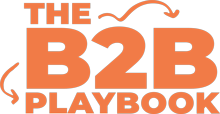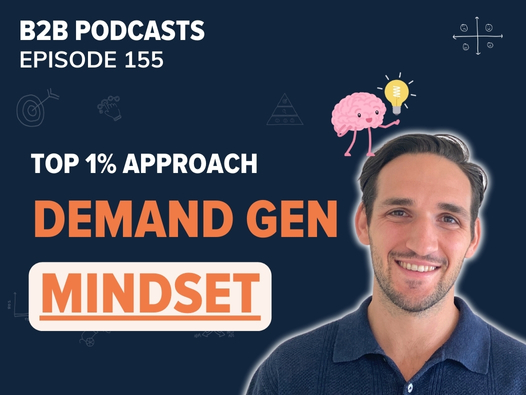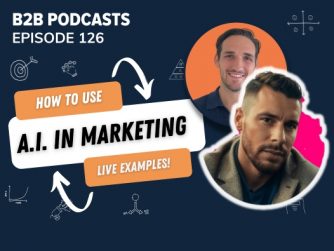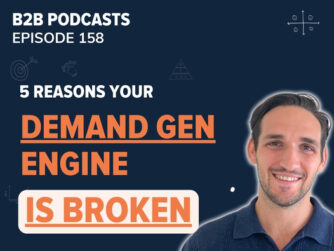So many B2B marketers think demand generation is some mysterious formula that only the big players have cracked. It’s not.
The truth? The best demand generation strategies are built on simple, fundamental principles. They’re about deeply understanding your audience, delivering consistent value, and staying top of mind.
In this article, we’ll break down the critical mindsets you need to adopt to make demand generation work for you. Keep reading, and I’ll show you how to shift your thinking, simplify your approach, and drive consistent growth for your business.
Listen To The Episode
Watch The Episode
The Demand Generation Mindset: No Secrets, Just Principles
So many B2B marketers think demand generation is this magical secret sauce, a hidden formula that only the big players have figured out. But I’m here to tell you there is no secret to demand generation – and that’s actually great news.
The most effective demand generation engines are often the simplest ones. They’re built on straightforward principles, not some elusive trick or complex strategy. It’s about knowing who your target audience is and making sure you’re helping them get what they want. Because when you do that, you’re not just running campaigns – you’re building real relationships and staying top of mind.
I see it all the time when we speak to companies and marketers. So many believe there’s a hidden key to cracking the demand generation code, that once they figure it out, they’ll never have to worry about revenue again. But that’s just not true. The truth is, there’s no one secret or shortcut. It comes down to understanding foundational marketing principles – knowing your audience deeply, delivering value consistently, and being relentlessly helpful.
Understanding Your Audience: The Key to Building Trust
You don’t have the resources to market to everyone who could ever buy your product. One of the biggest mistakes I see B2B marketers make is thinking they need to reach an overly broad audience to drive demand. But the reality is, the more you narrow down and define your target audience, the better you can help them – and that’s where the magic happens.
“You have to clarify exactly who you’re marketing to. You need to segment down and niche down because quite simply, your business, your particular team just can’t afford to market to everyone.”
George Coudounaris – The B2B Playbook – 00:05:50
If you try to speak to everyone, you’ll end up speaking to no one. Instead, focus your energy on a specific group that you can serve better than anyone else. That’s how you build trust.
When we started building our own framework, we knew we needed to narrow our focus. We realized that our approach was really well-suited for small B2B marketing teams – the underdogs who needed to make a big impact with limited resources. Why? Because we were part of those small teams. We understood the challenges they faced and the specific help they needed.
“We realized that our framework, because of our experience, was really, really well-suited to B2B marketing… initially it was those B2B marketers who are in small teams because we were part of those small teams.”
George Coudounaris – The B2B Playbook – 00:07:10
That focus allowed us to go deep instead of wide, to build genuine trust by offering content that directly spoke to their challenges. And you know what? The more we narrowed down, the better we could help them.
Don’t waste your resources trying to be everything to everyone. Niche down, get crystal clear on who you’re trying to help, and then put all your energy into being the best possible solution for that audience. That’s how you build trust. And trust is the real currency in demand generation.
Building Trust Through Consistency: Awareness vs. Affinity
There’s a huge difference between awareness and affinity, and it’s a mistake to confuse the two. Just because people know your brand exists doesn’t mean they actually care about it. What you really want is affinity – a positive association where your audience knows, likes, and trusts you.
Think about it. Who cares if people just know the name “The B2B Playbook”? That doesn’t mean much. What we want is for them to know why we’re The B2B Playbook – that we’re experts in demand generation and fantastic at training marketers.
And building that kind of trust and association in the mind of the customer doesn’t happen overnight. It takes time, repetition, and consistency. You need to put your content in front of the same people, again and again, before it even starts to resonate.
That’s why we give away a lot of the answers to our framework – because every time we help someone with their day-to-day challenges, we’re building trust. They see us as the go-to experts, and when they’re ready to take the next step, we’re the first ones they think of.
So, the key is to show up consistently with valuable content that truly helps your audience. And to do that effectively, you need a system. Without one, you’ll quickly fall out of the conversation when they start making their shortlist of vendors.
The 95:5 Rule: The Rewards of Demand Gen will Compound
If you’ve been following The B2B Playbook, you know we talk about the 95:5 rule a fair bit. The 95:5 rule dictates that roughly only 5% of your market is actively ‘in-market’, looking to purchase something right now. The other 95% are not. That means the majority of your target audience isn’t ready to purchase today, but that doesn’t mean they’re not important.
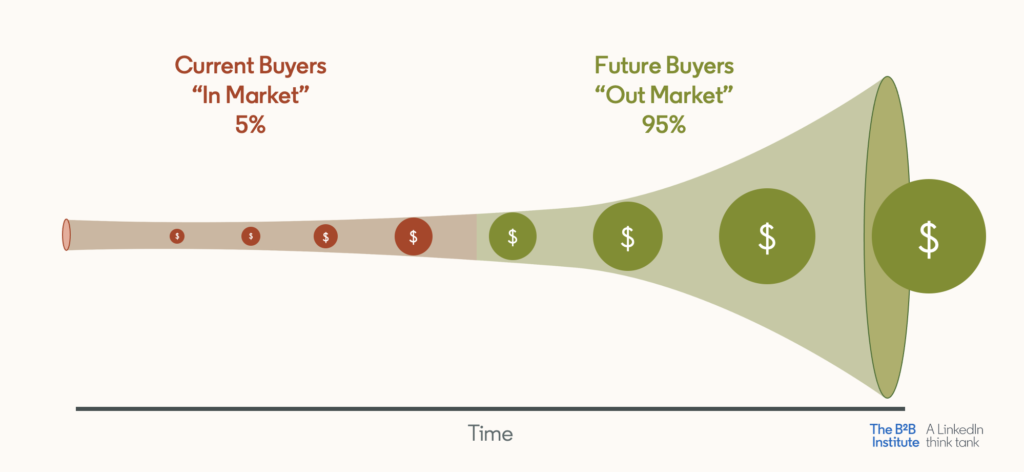
This is where a lot of B2B marketers trip up. They focus only on that small slice of the pie – the 5% who are in buying mode – and wonder why they struggle to scale.
“If all you’re ever doing is targeting that 5 percent of the market that’s ready to buy right now, it’s actually really difficult to grow and scale your business within that 5 percent.”
George Coudounaris – The B2B Playbook – 00:19:35
The problem with only focusing on the immediate buyers is that you’re limiting yourself to a very small, highly competitive pool.
So, what’s the solution? You need to play the long game. You’ve got to stay visible and relevant to the other 95% of the market that isn’t ready to buy yet. Demand generation is about making sure you stay top of mind, building relationships with that other 95 percent of the market. So when they’re ready to buy, they buy from you.
Let me give you a real-world example. I recently had five meetings with marketers interested in joining The B2B Incubator. Of those five, some had been following us for two years, others for 18 months, and some had discovered us just days before.

If we had only started demand generation six months ago, we might’ve had just two meetings. If we started 18 months ago, we’d have four. But because we’ve been consistently staying top of mind for the last two years, we had five.
The lesson is – start now. Engage with your audience before they’re ready to buy. Build relationships, deliver value, and stay consistent. That way, when the time comes and they’re ready to make a purchase, you’re the first name on their list. That’s how you win with demand generation.
Systems and Frameworks: The Backbone of Consistent Demand Generation
Consistency is everything in demand generation. But let’s be real – staying consistent without a proper system? That’s a recipe for burnout. If you’re trying to do it all manually, you’re going to struggle to keep up. And if you’re inconsistent, you risk falling off the radar when your prospects are making those all-important buying decisions.
“If you don’t have a system for doing that… there’s a good chance that you’re going to fall out of that conversation when they start making that shortlist of vendors.”
George Coudounaris – The B2B Playbook
For us, it’s all about having a content repurposing system. Everything starts with this podcast episode, and from there, it flows into LinkedIn posts, blog articles, newsletters – you name it. This system allows us to be super efficient. We get all this content out there in about five hours a week.
That’s the beauty of having a framework – you know exactly what’s coming, and the process becomes smooth, almost boring.
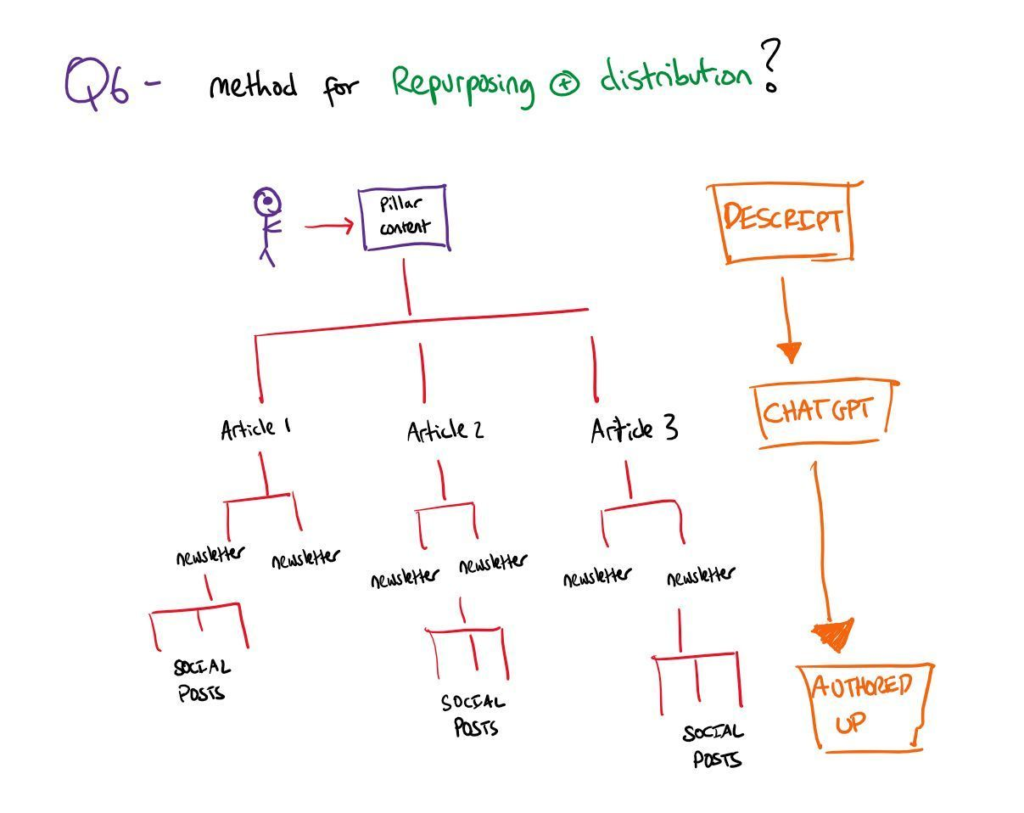
When we started, we were just focused on recording the podcast. That was it. We weren’t thinking about content repurposing at the time. Over time, as we got more comfortable with the process, we built up our repurposing strategy and expanded across more platforms.
“You might be working on a month-to-month basis of content… then over time, as you get used to putting that fundamental piece of content out there, you can start to work on your repurposing processes.”
George Coudounaris – The B2B Playbook
If you want to stay consistent with your demand generation, build systems that support you. Start small, get the basics right, and scale up as you grow. Your framework should make the process easier and more predictable, so you can focus on what really matters – delivering value to your audience.
The Crawl, Walk, Run Approach: Start Small, Scale Big
Trying to do everything all at once is a sure-fire way to get overwhelmed. That’s why I’m a big believer in the “Crawl, Walk, Run” approach.
When we first started with The B2B Playbook, we were barely crawling. All we focused on was recording the podcast. That’s it. No fancy distribution plans, no elaborate repurposing strategies. It was basic, but it worked because we were laying the foundation for what came next.
Over time, we refined our process. We started looking at how we could repurpose content from the podcast into LinkedIn posts, articles, and newsletters. This allowed us to stretch the value of each episode and create a more streamlined process for getting our message out there.
And here’s the thing – once you have those systems in place, you can start speeding things up. What was once a monthly task can become weekly, and eventually, daily, if you have the resources.
But you can’t run before you can walk, and you can’t walk before you can crawl. When we first started, we didn’t even figure out our second distribution channel until months into producing the podcast.
The key is to start small, focus on getting the basics right, and then scale up as your processes improve. Demand generation isn’t a race – it’s a marathon. So take your time, build your systems, and soon enough, you’ll be running.
Feedback Loops: The Secret to Continuous Improvement
Consistency is key in demand generation, but here’s the catch: you can’t just keep your head down and blindly execute the same strategy over and over. You need to be listening, adapting, and improving as you go. That’s where feedback loops come in.
“Feedback loops are important as well. So when it comes to the mindset of consistency, yes, we need to just relentlessly execute, but also have feedback loops that are open.”
George Coudounaris – The B2B Playbook
Think about it – if you’re not taking the time to understand what’s working and what’s not, you’re missing a huge opportunity to refine your approach. Source those insights from customers directly, or make sure you at least have sales and customer success passing some of those back to you.
It’s not just about cranking out content – it’s about creating the right content that resonates with your audience. And the only way to know that is by keeping those feedback loops active.
In our own demand generation system, we’re constantly getting insights from our sales and customer success teams. If they tell us that a particular piece of content is driving conversations, we double down on that. We don’t just blindly stick to our plan – we let feedback guide us so that we’re always improving.
Next Steps & Action For You
So, here’s the bottom line: demand generation isn’t about chasing secrets or shortcuts. It’s about adopting the right mindset, building trust with your audience, and staying consistent with your efforts. Start by deeply understanding who you’re marketing to, create systems and frameworks that make it easy to show up consistently, and always keep those feedback loops open. That’s how you stay top of mind and build a sustainable growth engine for your business.
The best time to start? Two years ago. The second-best time? Right now. You don’t need to have it all figured out from day one. Start small, get the basics right, and scale up as you go. Remember, you’re not just capturing demand from =the 3-5% ready to buy today – you’re building relationships with the 95% who will need you tomorrow.
If you’re ready to put these ideas into practice, check out our demand gen course The B2B Incubator. We’ll give you the strategy, the templates, and the tools to build your demand generation engine in just 12 weeks. No more spinning your wheels, no more guessing. Let’s get you off that marketing activity hamster wheel and onto a path that delivers real results.
